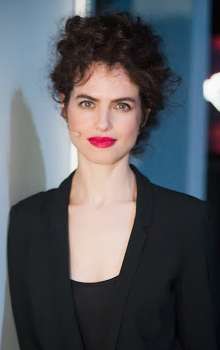Neri Oxman
| Neri Oxman | |||||||||
|---|---|---|---|---|---|---|---|---|---|
|
Neri Oxman in Montreal, 2013 | |||||||||
| Native name | נרי אוקסמן | ||||||||
| Born |
1976 (age 39–40) Haifa, Israel | ||||||||
| Nationality | Israeli, American | ||||||||
| Alma mater |
Technion Hebrew University Architectural Association MIT | ||||||||
| Occupation | Associate professor of media arts and science[1] | ||||||||
| Notable work |
Silk Pavilion (2013) Wanderers (2015) | ||||||||
| Spouse(s) | Osvaldo Golijov (divorced) | ||||||||
| Awards |
Vilcek Prize, 2014 Earth Award, 2009 | ||||||||
| |||||||||
Neri Oxman (נרי אוקסמן, Hebrew pronunciation: neʁi ˈoksman; born 1976) is an American–Israeli architect, designer, and professor at the MIT Media Lab, where she leads the Mediated Matter research group. She is known for art and architecture that combine design, biology, computing, and materials engineering.
Her work embodies environmental design and digital morphogenesis, with shapes and properties that are determined by their context. She coined the phrase "material ecology" to define her work, placing materials in context.[2][3] Stylistic trademarks include brightly colored and textured surfaces with structure at many scales, and composite materials whose hardness, color, and shape vary over an object. The results are often designed to be worn or touched, and inspired by nature and biology.
Many of Oxman's projects use 3D printing and fabrication techniques. They include the Silk Pavilion, spun by silkworms released onto a nylon frame,[4] Ocean Pavilion, a water-based fabrication platform that built structures out of chitosan,[5] G3DP, the first 3D printer for glass and a set of glasswork produced by it,[6] and collections of 3D-printed clothing and wearables worn in couture shows and by performers such as Björk.[7]
She has held regular exhibitions at the Museum of Modern Art and Boston's Museum of Science, which have some of her pieces in their permanent collections. She has been recognized for contributing to new ways of thinking about making things, both within and outside of the design world. MoMA curator Paola Antonelli called her "a person ahead of her time, not of her time",[8] and Bruce Sterling called her work "shatteringly different from anything before".[9]
Personal life and education
Oxman was born and raised in Haifa, by architect parents Robert and Rivka Oxman. She grew up "between nature and culture", spending time in her grandmother's garden and her parent's architectural studio. In 1997, she moved to Jerusalem to enter Hebrew University's Hadassah Medical School. After two years she switched to studying architecture at the Technion, and then at the London Architectural Association School of Architecture, graduating in 2004.[10]
In 2005 she moved to Boston to join the architecture PhD program at MIT, under adviser William J. Mitchell. Her thesis was on material-aware design.[11] In 2010, she became an associate professor at MIT.
Oxman was previously married to composer Osvaldo Golijov.[8]
Career
Oxman's work has been displayed around the world, with pieces in the permanent collections of the Museum of Modern Art, the Cooper Hewitt Design Museum, the Centre Georges Pompidou, Vienna's Museum of Applied Arts, SFMOMA, and Boston's Museum of Fine Arts and Museum of Science.[12] Exhibits have also been shown at the Smithsonian, and the Beijing International Art Biennale.[13]
She published papers on parametric and contextual design, and developed specific engineering techniques to realize those designs in various materials. In 2006, she launched an interdisciplinary research project at MIT called materialecology, to experiment with generative design.[14][15] This project and related collaborations informed her early art. She has promoted the idea of finding new ways to communicate about and collaborate on design. In 2016, she helped launch the open multidisciplinary Journal of Design Science.[16]
She has appeared on the covers of Fast Company,[17] Wired UK,[18] ICON,[19] and Surface Magazine.[20] Her work is mentioned as an inspiration for changing how materials and structures are designed, and her artistic works were described by Andrew Bolton as "otherworldly—defined by neither time nor place".[21]
On becoming a professor in 2010, Oxman founded the Mediated Matter research group at the MIT Media Lab. There she expanded her collaborations into biology, medicine and wearables.
Design philosophy
Oxman writes about the world and environment as organisms, changing regularly and responding to use. She proposed developing a material ecology with "holistic products, characterized by property gradients and multi-functionality" – in contrast to assembly lines, and “a world made of parts". On the interplay between design and fabrication methods, she said "the assumption that parts are made from single materials and fulfill predetermined functions is deeply rooted in design... [and] enforced by the way that industrial supply chains work.”[22]

She describes her work as pursuing "a shift from consuming nature as a geological resource to editing it as a biological one."[23][24] This leads to using biological shapes and textures for inspiration, and including living elements in fabrication processes, such as the glowing bacteria in Mushtari and using silkworms to construct the Silk Pavilion.[4] She has written that science, engineering, design and art should be more actively connected – with the output of each discipline serving as input for another.[25]
Oxman has given presentations on digital and cross-disciplinary design, and on moving beyond mass-produced design elements. These included a presentation on form generation and environmental design,[26] cited by rapid prototypers in other fields,[27] and a popular TED talk on designing "at the intersection of technology and biology".[22] Her 2016 keynote at the American Institute of Architects conference proposed "a more profound role for architecture in society", by working hand-in-hand with science and engineering.[28]
Mediated Matter
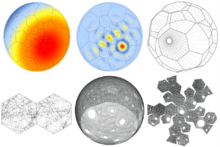

The Mediated Matter group uses computational design, digital fabrication, materials science and synthetic biology to explore design possibilities in small and large structures.[12][23] This sometimes involved taking images of a biological sample, developing algorithms to produce similar structures, and developing new manufacturing processes to realize the results.
Projects have included wearables inspired by current and future environments,[29] solar-powered and biodegradable designs,[30] new artistic techniques, and experimental surfaces, walls, coverings and load-bearing elements. Some of these involved combining work from many fields.
Organic and natural fabrication
A number of Oxman's works have involved fabrication by animals or by natural processes.
The Silk Pavilion, an installation designed in 2013, was noted for its fabrication method as much as its final form. It was woven by 6,500 free-ranging silkworms on a nylon-frame dome. Experiments with the silkworms identified how they would respond to different surfaces, and what would encourage them to spin onto an existing structure rather than spinning a cocoon. The frame of a large polyhedral dome was loosely woven out of thin nylon threads, and suspended in an open room. This structure was designed with gaps where it would be warmest. Silkworms were released onto the frame in waves, where they added layers of silk before being removed. This involved engineering, sericulture, and modelling sun in the room. The resulting installation art was hung so that people could stand inside it.
The Ocean Pavilion, an installation from 2014, included a water-based fabrication platform where structures were built out of chitosan, a water-soluble organic fiber similar to chitin. Structural pillars and long delicate leaves were made by varying how the fibers were deposited.[5]
The Synthetic Apiary, a room-sized installation built in 2015, studied the behavior of bees in an entirely indoor environment, including how they built hives in and around different structures. This was developed in collaboration with a beekeeping company, as a way of testing possible responses to colony loss, and exploring how biological niches could be explicitly integrated into buildings.[31]
3D printing developments
Mediated Matter worked extensively with various 3D printing techniques, developing their own methods and collaborating with printing companies such as Stratasys. Projects have ranged in scale from enclosures and large furniture, to artwork and clothes, to biocomposites, artificial valves, and DNA assembly. The group designed a printer model for large outdoor spaces, and one to make free-standing objects without support structures.
In 2012, Oxman printed the first of many sets of body-sized wearables, in a collection titled Imaginary Beings, inspired by legendary creatures. This was followed by Anthozoa, a dress developed in collaboration with fashion designer Iris van Herpen and materials engineer Craig Carter. In 2015, she designed the Wanderers collection with Christoph Bader and Dominik Kolb, inspired by ideas of interplanetary exploration. That work earning Fast Company's design innovation award. The most influential piece was the Living Mushtari chestpiece, with a model digestive tract filled with a colony of photosynthetic bacteria and E. Coli.[32] Producing it required new methods for printing long flexible tubes with varying thickness. In 2016, she developed a technique for printing form-fitting objects for the Rottlace project,[33] designing a series of masks for the artist Björk, starting with a model of her face. Björk wore one of the masks for the world's first 360° VR performance.[7]
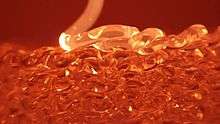
Oxman has also developed a number of new printing techniques and combinations. In 2015, she designed Gemini, a large chaise lounge that combined a milled wood shell, and a 3D printed surface, tuned for acoustical properties. It was later acquired by SF MoMA.[34]
Working with MIT's Glass Lab and researchers the Wyss Institute, her group developed G3DP, a project to 3D print glass vessels and structures.[35] At the time, no commercial printer could work with glass, so they built their own. It poured molten glass in fine streams[36] with precision suitable for art, product and architecural design, allowing close control of transparency and other optical properties.[37][38][39] A set of museum-quality glass vessels made with this printer went on exhibit at the Cooper Hewitt museum the following year.[40]
Publications and essays
- 2016: What if our buildings were grown, not built?[23]
- 2015: Material Ecology[41]
- 2014: Gemini: Multi-Material Digital Design Fabrication[42]
- 2011: Variable Property Rapid Prototyping[43]
- 2006: Tropisms: Computing Theoretical Morphospaces of Branching Growth Systems[44]
Group publications
Exhibited works
Oxman's early projects took the form of example surfaces, furniture, or objects that could be easily put on display. Most of them have been collected by museums and exhibited as works of art. More recent work such as G3DP include an entire production process and machinery.
Selected works

- Cartesian Wax, Monocoque, Subterrain[49] (2007, MoMA)[50]
- Raycounting, Penumbra (2007, MoMA)
- Fatemaps (2008, Museum of Science)
- Fibonacci’s Mashrabiya (2009, 12, Centre Pompidou)
- Beast: Prototype for a Chaise Longue (2010, MoS)
- Carpal Skin[51] (2010, MoS)
- Silk Pavilion (2012), installation
- Imaginary Beings collection (2012, Centre Pompidou)
- 18 pieces, 'wearables for demigods'
Gallery
- Surfaces and art
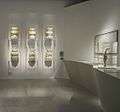 Raycounting and Mashrabiya, FRAC
Raycounting and Mashrabiya, FRAC Raycounting, multiply lit
Raycounting, multiply lit Monocoque 2, MoMA
Monocoque 2, MoMA Subterrain, MoMA
Subterrain, MoMA Beast chaise model
Beast chaise model
- Furniture, wearables, and installations
 Anthozoa dress
Anthozoa dress Mushtari living corset
Mushtari living corset G3DP glass printer
G3DP glass printer Silk Pavilion under construction, MIT
Silk Pavilion under construction, MIT Silk Pavilion construction
Silk Pavilion construction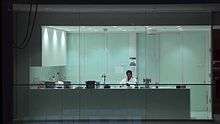 Synthetic Apiary development
Synthetic Apiary development
Selected exhibits
Beijing Art Biennale: 2006-2010
MoMA, New York: 2007, 2010 (Action: Design over Time), 2015 (This Is for Everyone)
Museum of Science, Boston: 2012 (Neri Oxman: At the Frontier of Ecological Design[53])
Cooper Hewitt Museum: 2015 (Making Design), 2016 (Beauty)
Centre Pompidou, Paris: 2012 (Imaginary Beings exhibit, Multiversités Créatives[54])
Science Museum, London: 2012 & 2013 (3D PRINT SHOW[55])
Museum of Fine Arts, Boston: 2013, 2016 (#techstyle: Production[56])
Awards and recognition
Oxman is a senior fellow in the Design Futures Council, and won the Vilcek Prize in Design in 2014.[58]
In 2009, she was on ICON’s list of the “20 Most Influential Architects to Shape Our Future.”[59] In 2012, Shalom Life ranked her #1 on its list of “most talented, intelligent, funny, and gorgeous Jewish women in the world."[60][61]
Other awards include:
- MIT Collier Medal (2016)
- Cultural Leader, World Economic Forum (2016)
- Innovation by Design Award, Fast Company (2015), for Wanderers[62]
- American Institute of Architects Women in Design (2014)[63]
- Carnegie "Pride of America" Award (2014)[64]
- Vilcek Prize in Design (2014)[58]
- Senior Fellow, Design Futures Council (2013)
- Earth Award for Future Crucial Design (2009)[65]
- Carter Manny Citation, Graham Foundation for the Arts (2008)
- Holcim Foundation Next Generation Award (2008), for "microstructure research for building skins"[66]
References
- ↑ Hill, David J. (June 4, 2012). "3D Printing Is The Future Of Manufacturing And Neri Oxman Shows How Beautiful It Can Be". singularityhub.com. Retrieved June 4, 2012.
- ↑ "Material Ecology website". Retrieved October 15, 2011.
- ↑ "Material Ecology". The Dirt. August 20, 2009. Retrieved April 25, 2011.
- 1 2 Silkworms and Robot work together to weave silk pavilion, Dezeen, June 3, 2013.
- 1 2 Mogas-Soldevila, Laia; Duro-Royo, Jorge; Lizardo, Daniel; Kayser, Markus; Patrick, William; Sharma, Sunanda; Keating, Steven; Klein, John; Inamura, Chikara; Oxman, Neri (2015). "DESIGNING THE OCEAN PAVILION: Biomaterial Templating of Structural, Manufacturing, and Environmental Performance" (PDF). Proceedings of the International Association for Shell and Spatial Structures (IASS) Symposium. Retrieved September 16, 2016.
- ↑ Environments from the Mediated Matter Lab.
- 1 2 3 "Björk to perform the world's first 360 VR stream - Dancing Astronaut". Dancing Astronaut. 2016-06-28. Retrieved 2016-08-02.
- 1 2 "Neri Oxman Is Redesigning the Natural World". Surface Magazine. June 6, 2016. Retrieved July 8, 2016.
- ↑ Sterling, Bruce (May 1, 2008). "Neri Oxman weaves nature's logic into design and makes buildings, architects, and Bruce Sterling sweat". ABITARE Magazine.
- ↑ Her masters thesis was on using "structural, spatial and environmental" cues to drive shape generation. Oxman, Neri (2004). Performative Morphologies.http://neri.media.mit.edu/assets/pdf/Publications_VH.pdf
- ↑ Material-based design computation, Neri Oxman, 2010. DSpace@MIT.
- 1 2 "Mediated Matter group website". MIT Media Lab. Retrieved June 15, 2016.
- ↑ Oxman, Neri (July 8, 2010). "Structuring Materiality: Design Fabrication of Heterogeneous Materials - Oxman - 2010 - Architectural Design - Wiley Online Library". Architectural Design. 80 (4): 78. doi:10.1002/ad.1110.
- ↑ Material Ecology blog, 2006-2013
- ↑ Oxman, Neri. "Material Ecology projects Neri Oxman". line feed character in
|title=at position 17 (help) - ↑ MIT Media Lab's Journal of Design Science, Liz Stinson, WIRED. March 10, 2016.
- ↑ "Most Creative People of 2009". Fast Company. 2010.
- ↑ "The Team at Wired are 3D Printing Obsessed". Retrieved 2016-08-02.
- ↑ O'Neal, Paul. "Neri Oxman on 3D Printing - Icon Magazine". www.iconeye.com. Retrieved 2016-08-02.
- ↑ "NO. 129 JUNE/JULY 2016". SURFACE. Retrieved 2016-08-02.
- ↑ Sullivan, Robert. “Future Perfect”, in VOGUE, Met Gala Special Edition, June 2016, pp. 44-45.
- 1 2 Design at the Intersection of Technology and Biology, 2015.
- 1 2 3 Neri Oxman. "What if our buildings were grown, not built?". World Economic Forum. Retrieved 2016-07-10.
- ↑ Oxman, Neri (December 7, 2012). "Five Tenets of a New Kind of Architecture". CNN.
- ↑ The Age of Entangelement, Neri Oxman, Journal of Design and Science. January 13, 2016.
- ↑ On Designing Form, PopTech 2009.
- ↑ Bibb, Richard (2015). Medical Modelling: The Application of Advanced Design and Rapid Prototyping Techniques in Medicine. Woodhead Publishing. pp. 313, 332. ISBN 9781782423003.
- ↑ "Perspectives on BEST of SHOW 2016", Architosh, June 3, 2016. The talk proposed "a more profound role for the architecture field in society", and received a standing ovation.
- ↑ Design Fiction: Neri Oxman, “Imaginary Beings: Mythologies of the Not Yet”, Wired magazine. May 12, 2012
- ↑ “Mushtari” Is a 3D Printed Wearable That Makes Products from Sunlight, ArchDaily. July 12, 2015
- ↑ "Neri Oxman + Mediated Matter Create Synthetic Apiary to Combat Honeybee Colony Loss". ArchDaily. 2016-10-05. Retrieved 2016-10-07.
- ↑ "MIT professor creates 3D printed 'wearable skin' for space exploration". 2014-12-03. Retrieved 2016-08-07.
- ↑ From "Roðlaus", Icelandic for "skinless".
- ↑ "Neri Oxman Further Pursues 3D Printing with Multi-Materials for her Latest Mythical Installation — "GEMINI"". Retrieved 2016-08-10.
- ↑ "MIT's Neri Oxman on the True Beauty of 3D Printed Glass". 2015-08-28. Retrieved 2016-08-12.
- ↑ Dorrier, Jason (September 9, 2015). "Watch MIT's Breakthrough 3D Printer Pour Molten Glass Like Honey". Singularity Hub. Singularity University. Retrieved August 1, 2016.
- ↑ Chandler, David (September 14, 2015). "Printing transparent glass in 3-D". MIT News. Retrieved July 9, 2016.
- ↑ "GLASS / G3DP – 3D printing of optically transparent glass". Retrieved 2016-08-03.
- ↑ Peach, Matthew (September 1, 2015). "US group develops 3D-printing technique for optical glass". optics.org. SPIE. Retrieved 2016-08-12.
- ↑ "Cooper Hewitt Design Triennial, Beauty". Cooper Hewitt. July 2016.
- ↑ Oxman, Neri; Ortiz, Christine; Gramazio, Fabio; Kohler, Matthias (2015-03-01). "Material ecology". Computer-Aided Design. Material Ecology. 60: 1–2. doi:10.1016/j.cad.2014.05.009.
- ↑ Oxman, Neri; Dikovsky, Daniel; Belocon, Boris; Carter, W. Craig (2014-09-01). "Gemini: Engaging Experiential and Feature Scales Through Multimaterial Digital Design and Hybrid Additive–Subtractive Fabrication". 3D Printing and Additive Manufacturing. 1 (3): 108–114. doi:10.1089/3dp.2014.1505. ISSN 2329-7662.
- ↑ Oxman, Neri (2011-03-01). "Variable property rapid prototyping". Virtual and Physical Prototyping. 6 (1): 3–31. doi:10.1080/17452759.2011.558588. ISSN 1745-2759.
- ↑ Oxman, Neri (2006). "Collective Intelligence in Design, pg 20.". AD (Architectural Design). 76 (5).
- ↑ Keating, Steven J.; Gariboldi, Maria Isabella; Patrick, William G.; Sharma, Sunanda; Kong, David S.; Oxman, Neri (2016-08-15). "3D Printed Multimaterial Microfluidic Valve". PLOS ONE. 11 (8): e0160624. doi:10.1371/journal.pone.0160624. ISSN 1932-6203. PMC 4985141
 . PMID 27525809.
. PMID 27525809. - ↑ Patrick, William G.; Nielsen, Alec A. K.; Keating, Steven J.; Levy, Taylor J.; Wang, Che-Wei; Rivera, Jaime J.; Mondragón-Palomino, Octavio; Carr, Peter A.; Voigt, Christopher A.; Oxman, Neri; Kong, David S. (2015-12-30). "DNA Assembly in 3D Printed Fluidics". PLoS ONE. 10 (12): e0143636. Bibcode:2015PLoSO..1043636P. doi:10.1371/journal.pone.0143636. ISSN 1932-6203. PMC 4699221
 . PMID 26716448.
. PMID 26716448. - ↑ Duro-Royo, Jorge; Mogas-Soldevila, Laia; Oxman, Neri (2015-12-01). "Flow-based fabrication: An integrated computational workflow for design and digital additive manufacturing of multifunctional heterogeneously structured objects". Computer-Aided Design. 69: 143–154. doi:10.1016/j.cad.2015.05.005.
- ↑ Klein, John; Stern, Michael; Franchin, Giorgia; Kayser, Markus; Inamura, Chikara; Dave, Shreya; Weaver, James C.; Houk, Peter; Colombo, Paolo; Yang, Maria; Oxman, Neri (2015-08-19). "Additive Manufacturing of Optically Transparent Glass". 3D Printing and Additive Manufacturing. 2 (3): 92–105. doi:10.1089/3dp.2015.0021. ISSN 2329-7662.
- ↑ Variable Property Analysis and Fabrication of a Butterfly Wing
- ↑ "Project list". Personal site. MIT Media Lab. Retrieved June 1, 2016.
- ↑ Prototype for a Carpal Tunnel Syndrome Splint
- ↑ Synthetic apiary: a perpetual spring environment. Retrieved September 15, 2016
- ↑ "Neri Oxman: At the Frontier of Ecological Design" (PDF). Museum of Science, Boston. Fall 2009. Retrieved July 1, 2016.
- ↑ Imaginary Beings: Mythologies of the Not Yet, Wired, May 2012.
- ↑ 3-D printing produces a fresh creative outlet for artists, L.J. Williamson, LA Times. March 10, 2013.
- ↑ What is the future of fashion?, Joe Incollingo, Boston Globe. March 7, 2016.
- ↑ Remora – EXEMPLARY: 150 YEARS OF THE MAK, MAK Blog. July 8, 2014.
- 1 2 "Media Lab's Neri Oxman awarded Vilcek Prize". MIT News. Retrieved 2015-11-11.
- ↑ "Architect, Designer Neri Oxman Uses Principles of Nature to Create, Build". Targeted News Service. November 3, 2010.
- ↑ Ashley Baylen (April 12, 2012). "Top 50 Hottest Jewish Women (10-1) - Page2". Shalom Life. Retrieved May 2, 2013.
- ↑ "Who the Hell Is Your New Wonder Woman?". 2013-12-04. Retrieved 2016-09-19.
- ↑ "Neri Oxman and SOM Among Fast Company's Innovation By Design Award Winners". 2015-09-18. Retrieved 2016-07-02.
- ↑ AIA Women in Design award winners, 2014
- ↑ Pride of America Honorees page
- ↑ Neri Oxman named winner of first Earth Award, Bustler, January 13, 2009.
- ↑ "Top sustainable construction projects in North America honored", Holcim Foundation
External links
| Wikimedia Commons has media related to Neri Oxman. |
- Mediated Matter site
- Material Ecology blog
- TED Talk: Design at the Intersection of Technology and Biology
